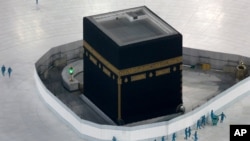Saudi Arabia has one of the highest coronavirus infection rates in the Middle East, with more than 213,000 confirmed cases and nearly 2,000 deaths as of Tuesday, prompting the custodian of Islam’s holiest shrines to restrict the annual Muslim hajj pilgrimage to a “small and limited” ritual event in accordance with safety guidelines. But scaling back the pilgrimage is expected to deepen the kingdom's economic slump, analysts say.
The U.S. Embassy in Riyadh has been helping organize special flights to take American citizens, including embassy staff and their dependents out of Saudi Arabia as coronavirus infections sharply increase.
Early on, the kingdom took strong measures to try to contain the COVID-19 pandemic, but as Middle East analyst Theodore Karasik at Gulf State Analytics told VOA, there were other mitigating factors at work in the country of 30 million.
"In Saudi, it was more of a lockdown. But Saudi Arabia is large, kind of porous, various levels of individuals within the society. They move back and forth across borders. So, the disease is kind of harder to control. There were outbreaks in Saudi Arabia just because one or two people who were infected went to visit someone else and winded up infecting the whole family. The other area getting high rates of infections was amongst migrant workers," he said.
Karasik has also worked professionally in containing pathogens and devised the United Arab Emirates business continuity strategy for disaster management. He said the Saudi authorities recognized the danger posed to grand mosques in Mecca and Medina and closed them right away.
Now, the Saudis are permitting a very limited hajj pilgrimage at the end of July compared to the more than two million pilgrims from over 180 countries who normally participate. Pilgrims will be made up of 70 percent residents of Saudi Arabia and 30 percent Saudi citizens. Saudi officials say health workers get priority.
No one who is not already inside Saudi Arabia is allowed to enter the kingdom for the pilgrimage.
Many had feared the pilgrimage, which packs colossal crowds into small religious sites, could be a massive source of contagion, Karasik said.
"The hajj will be done mostly internal to Saudi Arabia. The way that revenues work in Saudi Arabia, particularly with missing the hajj is going to be, of course, financially damaging to them. They will squeeze their belt and go through this process because at the end of the day the custodianship is more important than revenue," Karasik said.
In normal times, analysts estimate that the pilgrimages add $12 billion —about 7% — to Saudi Arabia’s GDP per year. They say that between 25 and 30 % of the private sector’s income in the Mecca and Medina areas rely heavily on the pilgrimage season.
The International Monetary Fund expects that Saudi Arabia’s GDP for 2020 will shrink by 6.8 percent as the coronavirus pandemic and low crude oil prices take their toll on the economy. Despite that, Saudi Arabia is pressing ahead with a $20 billion mega-tourism project in the capital, Riyadh, hoping consumer spending will rebound once the virus abates.






